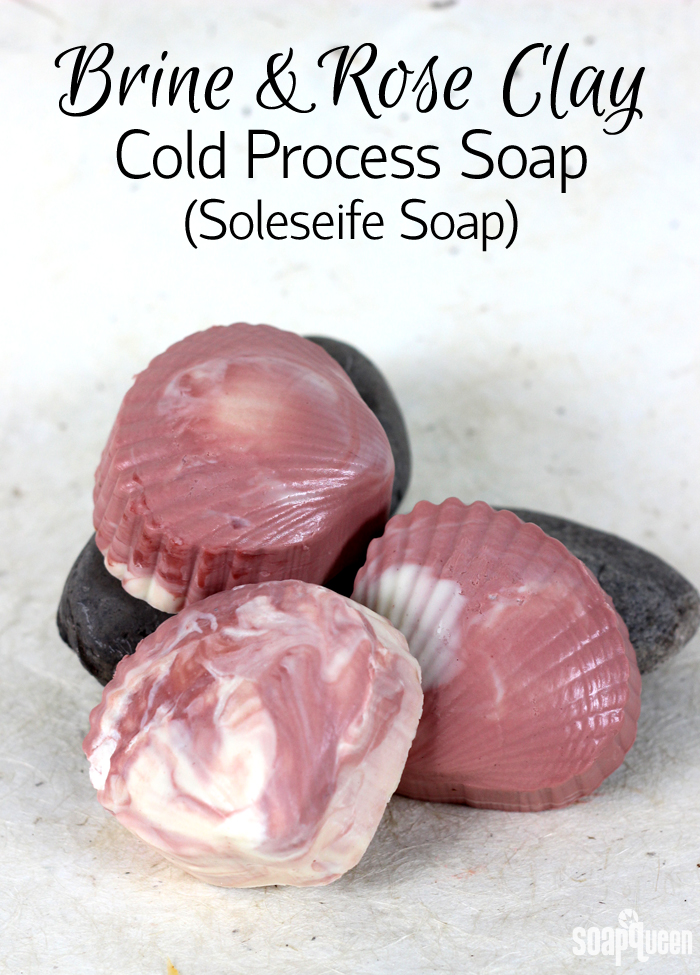
A typical cold process salt bar involves adding salt crystals at trace. These are wonderful bars, but they tend to be crumbly and may not last as long, as the salt dissolves with use. Soleseife (or brine soap) is the German name for soap made with salt water. Brine soap is a fantastic alternative to the standard salt bar. The salt is dissolved into the lye water leaving a smooth-textured, creamy white, extremely hard bar of soap. Salt does decrease lather – but this can be counteracted with a high percentage of coconut oil in your recipe. Just be sure to use a high superfat so it does not become drying.
This recipe was actually the inspiration behind the Lavender and Rose Pink Salt Bars. Using a similar design of an in-the-pot swirl with rose clay, these bars look similar but feel drastically different. It’s amazing how using salt water rather than adding salt at trace changes the look and feel. If you’re looking for a small amount of exfoliation, I would recommend adding salt at trace like in the Lavender and Rose Pink Salt Bars. If you like a smooth feel, brine soap is the way to go. Both techniques produce an extremely creamy lather.
What You’ll Need:
Note: This recipe uses a 10% superfat to counteract the high percentage of coconut oil in this recipe.
Clam Shell Mold
3.6 oz. Distilled Water
1.6 oz. Sodium Hydroxide Lye
.5 oz. Pink Himalayan Sea Salt (Extra Small) (14% of the water amount)
8.3 oz. Coconut Oil (75%)
1.9 oz. Olive Oil (17%)
0.6 oz. Avocado Oil (5%)
0.3 oz. Castor Oil (3%)
Rose Clay
0.5 oz. Lemongrass Essential Oil

Click here to add everything you need for this project to your Bramble Berry shopping cart!
If you’ve never made Cold Process soap before, stop here! I highly recommend checking out our FREE four part SoapQueen.tv series on Cold Process Soapmaking, especially the episode on lye safety. And if you’d rather do some reading, Bramble Berry carries a wide range of books on the topic, including my newest book, Soap Crafting. You can also checkout the digital downloads for that instant gratification factor.
SAFETY FIRST: Suit up for safe handling practices! That means goggles, gloves and long sleeves. Make sure kids, pets, and other distractions and tripping hazards are out of the house or don’t have access to your soaping space. Always soap in a well-ventilated area.
FRAGRANCE PREP: Measure .5 ounces of the lemongrass essential oil in a glass, essential oil safe container. Set aside.
COLOR PREP: Disperse 1.5 teaspoons of the Rose Clay into 1.5 tablespoons of distilled water. Clays are best dispersed in water rather than oil because of their ability to absorb moisture.
ONE: Slowly and carefully add the lye to the water and gently stir until the lye has fully dissolved. While the lye water is still very hot, add the pink sea salt and stir until most of the salt is dissolved. A small amount may remain undissolved. Be very careful while stirring, and be sure to have on all your safety gear. Set lye aside.
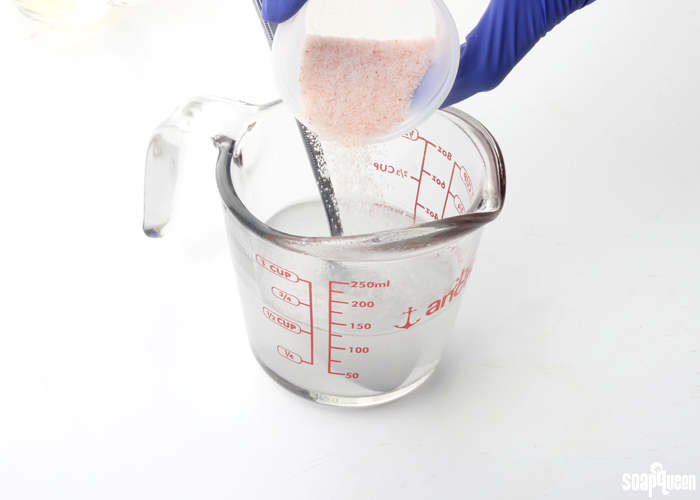
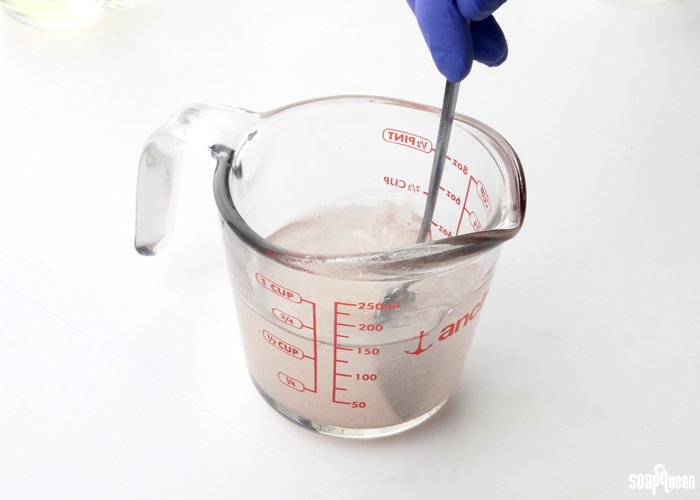
TWO: Melt and combine the coconut oil, olive oil, avocado oil and castor oil. Once the lye water and the oils have cooled to 120 degrees or below (and are ideally within 10 degrees of each other), add the lye water to the oils and stick blend until thin trace. The large amount of coconut oil and salt will cause this batter to thicken quickly, so be careful to not over blend.
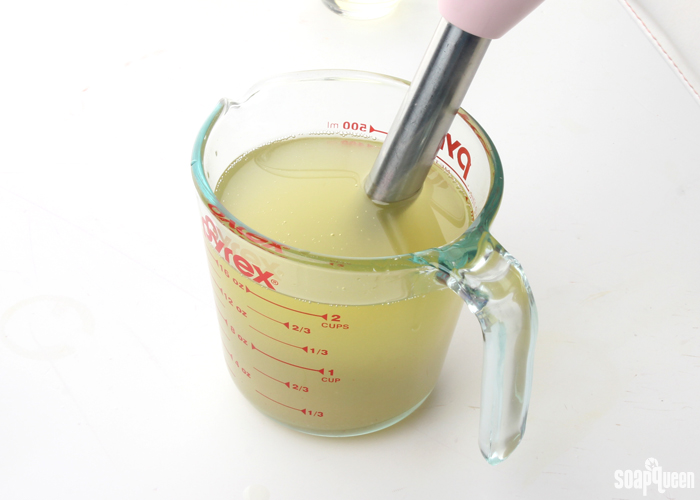
THREE: Once you’ve reached a thin trace, whisk in the lemongrass essential oil. Then, split off about 1/3 of the soap batter (it’s okay to eyeball it) into a separate container. Add all of the dispersed rose clay to this container and use a whisk to fully mix in.
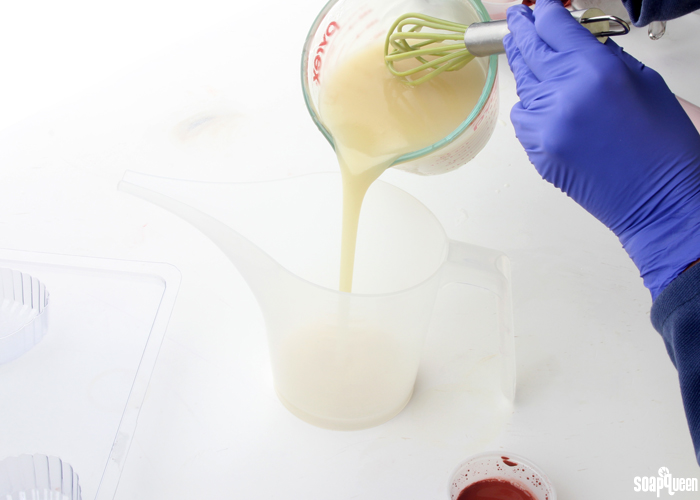
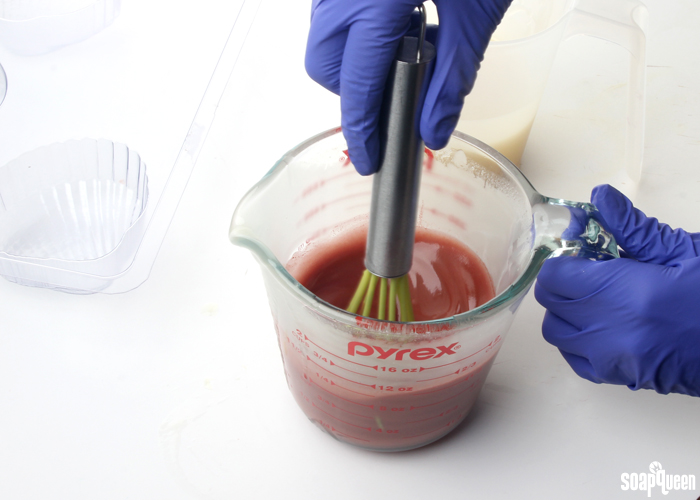
FOUR: Stir the uncolored batter to loosen the trace. Next, pour the pink batter into the uncolored batter in a circular pattern. Pour the batter from several inches above the other container to make sure the pink soap breaks through down to the bottom of the container.
FIVE: Pour the combined batters into the mold cavities. Spritz the top of the soap with 99% isopropyl alcohol to help prevent soda ash. Allow the soaps to set for 24-48 hours before unmolding. Cure soaps for 4-6 weeks before using and enjoy!
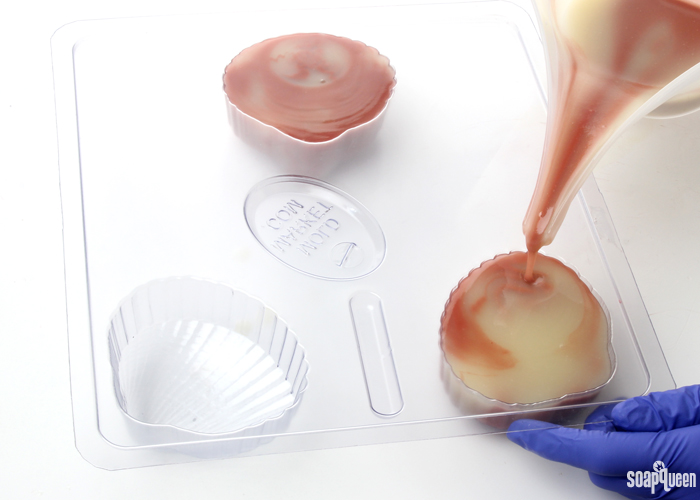
How do you prefer to incorporate salt into your soap?
- Clam Shell Mold
- 3.63 oz Distilled Water
- 1.6 oz Sodium Hydroxide Lye
- .5 oz Pink Himalayan Sea Salt (Extra Small) (14% of the water amount)
- 8.3 oz Coconut Oil (75%)
- 1.9 oz Olive Oil (17%)
- 0.6 oz Avocado Oil (5%)
- 0.3 oz Castor Oil (3%)
- Rose Clay
- 0.5oz Lemongrass Essential Oil
- Slowly and carefully add the lye to the water and gently stir until the lye has fully dissolved. While the lye water is still very hot, add the pink sea salt and stir until most of the salt is dissolved. A small amount may remain undissolved. Be very careful while stirring, and be sure to have on all your safety gear. Set lye aside.
- Melt and combine the coconut oil, olive oil, avocado oil and castor oil. Once the lye water and the oils have cooled to 120 degrees or below (and are ideally within 10 degrees of each other), add the lye water to the oils and stick blend until thin trace. The large amount of coconut oil and salt will cause this batter to thicken quickly, so be careful to not over blend.
- Once you’ve reached a thin trace, whisk in the lemongrass essential oil. Then, split off about ⅓ of the soap batter into a separate container. Add all of the dispersed rose clay to this container and use a whisk to fully mix in.
- Stir the uncolored batter to loosen the trace. Next, pour the pink batter into the uncolored batter in a circular pattern. Pour the batter from several inches above the other container, to make sure the pink soap breaks through down to the bottom of the container.
- Pour the combined batters into the mold cavities. Spritz the top of the soap with 99% isopropyl alcohol to help prevent soda ash. Allow the soaps to set for 24-48 hours before unmolding. Cure soaps for 4-6 weeks before using and enjoy!
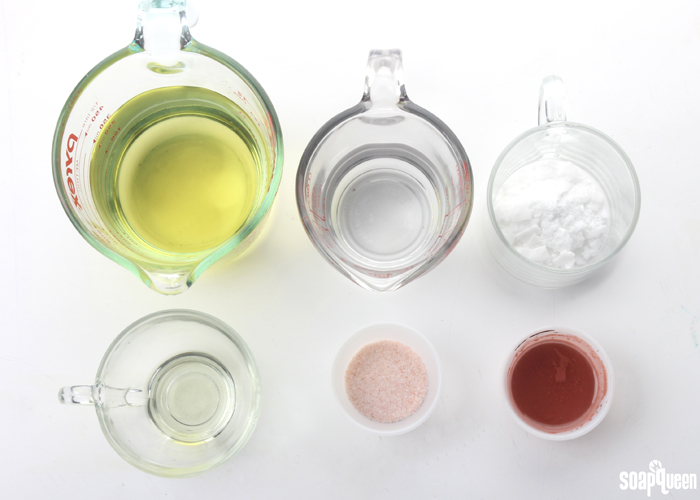
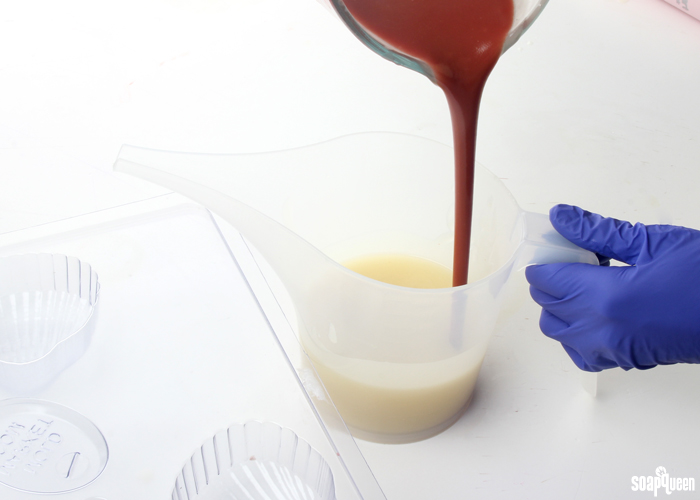
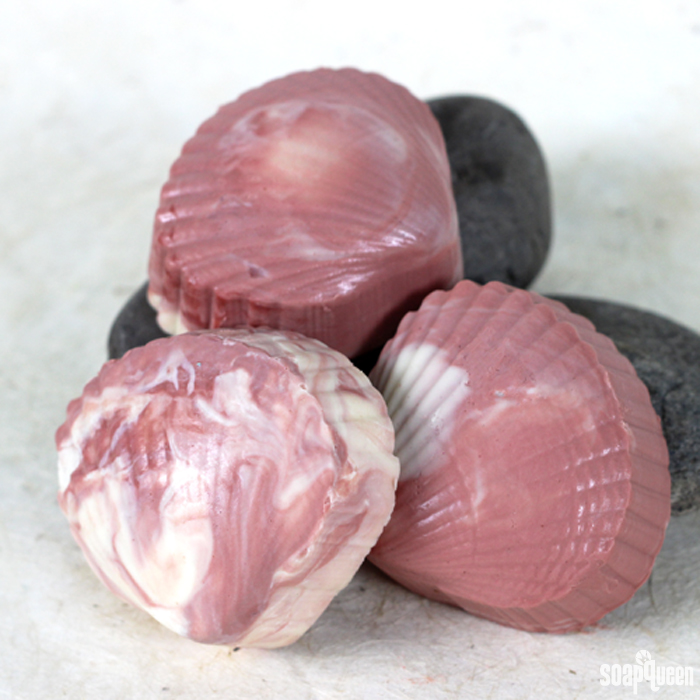
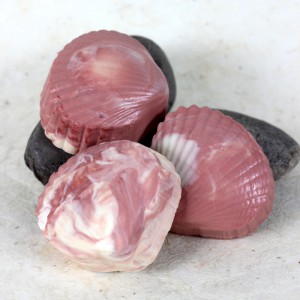

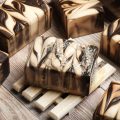

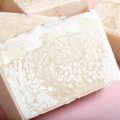
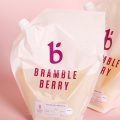
I love you guys, but I have to admit I am occasionally frustrated, and this was another recipe that frustrated me. I do not have wee shell molds, but I love the recipe, and wanted to adjust the quantities to fit a loaf mold. The problem is that it is set in ounces, and not in percentages. If it was to do a 6 ounce batch for shell molds, but you listed the recipe in percentages, I could adjust it to my current loaf mold size, and have a chance to try the recipe. Don’t you ever list recipes in percentages? I have made soap with salt before, but they were always crumbly, and I would love to do this one with the clay and the salt water.
This recipe does have those percentages listed. Next to the oil amounts you’ll see 8.3 oz Coconut Oil (75%) – that 75% is the percentage of oil to use. To adjust that recipe, just plug those percentages and the weight of your recipe into our Lye Calculator: https://www.brambleberry.com/Pages/Lye-Calculator.aspx
We used 14% salt for this recipe. So for instance, if I had 10 ounces of water, I would add 1.4 ounces of salt (10 x .14). I’ll add that to the recipe to make it more clear. Sorry for any confusion.
As for the clay, I would recommend prepping double the amount for your recipe, then adding 1 dispersed teaspoon at a time until you get a color you like.
Use the Fragrance Calculator to find out how much scent to add to your batch: https://www.brambleberry.com/Pages/Fragrance-Calculator.aspx
Also, salt bars can be tricky in loaf molds. They harden in just a few hours, and if they’re not cut soon enough they will crumble. I would recommend checking the loaf after just an hour. If it’s firm, you’ll want to cut it then (wearing gloves).
-Kelsey with Bramble Berry
This soap is so pretty, but I do wish I’d read this comment first. I poured my soap into a mold. When I unmolded 24 hours later the bars crumbled as they were cut. I still love the colour and how the swirl turned out. They won’t be gifts but I can use a crumbly edged bar quite happily and I learnt something too! Its early days in my soaping foray, I’m sure there will be many more ‘family only’ soaps to come.
Absolutely, the bars will still feel amazing on the skin. 🙂
Is it possible to substitute frozen goats milk for the water in this recipe and disolve the salt in the milk/lye mixture?
Because the goat milk and lye mixture is cooler, the salt may not dissolve as well as it does in hot lye water. You may try a small test batch to see what you think. If the salt doesn’t dissolve, you can try dissolving it in some hot distilled water, letting that cool, and combining it with your lye milk. Just remember to discount the milk so the batch doesn’t get too wet.
-Kelsey with Bramble Berry
Hi Kelsey,
Thanks for the recipe. Would it be possible to add salt to goat milk before freez the milk for water substitution? Will it work fine?
Thank you.
To get it incorporated you’ll need to heat the milk, which can cause scorching. You may try the water method – dissolving the salt in some hot distilled water, letting that cool, and combining it with your lye milk. Just remember to discount the milk so the batch doesn’t get too wet.
A fairly late response here: I made this up last summer, after cure, I found that it was far too drying for me, even though I loved how hard and fluffy the lather was.
Well, I tried it again today and wow. Its still a little harsh for my taste, but its absolutely lovely soap. I poured into really detailed molds and they came out lovely. I do with it was a touch gentler for my personal tastes.
Just read how vague that note above was…LOL! I love how hard the bar turned out and I tried those original bars that are now 8 months old. This is one that seemed to improve with time.
Glad to hear that Belinda. If you want to make it a bit more gentle, you can add more olive oil. The lather won’t be as big, but it will be more moisturizing on the skin.
-Kelsey with Bramble Berry
Hello,
I may be being super slow but how much clay are you meant to add and how do you know. I have been trying to read up about it but I am so confused on how to work out how much clay the recipe calls for.
Thank you
Tick
You’ll want to prepare 1.5 teaspoons of rose clay in 1.5 tablespoons of distilled water. Then, you’ll add all of that to 1/3rd of the soap batter. The color amounts are in the “Color prep” section. Sorry for any confusion!
In general, we recommend about 1 teaspoon of clay per pound of soap. However, you can adjust that based on the color or your personal preference. Learn more about working with color here: https://www.soapqueen.com/bramble-berry-news/sunday-night-spotlight-brazilian-clay/
-Kelsey with Bramble Berry
Do you take the 1.5 tbsp water for the rose clay from the total 3.6 oz of water? Thanks.
That will be a separate, additional amount of water, not taken from the total. Clay absorbs moisture, so if it’s added without water it can accelerate and form clumps. The water makes it easier to work with.
-Kelsey with Bramble Berry
Thank you for your quick reply. I was in the middle of preparing my ingredients 🙂 Glad I did the right thing! Can’t wait to unmold it!
You’re welcome! These bars feel amazing on the skin. Enjoy. 🙂
-Kelsey with Bramble Berry
Sorry I have another question 😀 Thank God for people like you, who are so helpful to share their knowledge,How do you calculate the amount of salt required?
Thanks
happy Soaping
We used 14% salt in this recipe! So for instance, if I had 10 ounces of water, I would add 1.4 ounces of salt (10 x .14). 🙂
-Kelsey with Bramble Berry
Thank you Kelsey, You guys are just amazing
You’re welcome Mary!
Gorgeous soap! as always,
I just have a question here why so high % of coconut soap won’t it be too drying? is a salt soap good for dry skin? what oils can i substitute for Olive & avocado? sorry too many questions 😛
Salt tends to weigh down lather, so the soap has a high coconut oil percentage to combat that. It also has a high superfat level (10%) so it won’t be too drying. The bars themselves feel nice and creamy on the skin and should be just fine to use for all skin types! That being said, everyone’s skin is different. You may want to test it on your skin to see if you like the way it feels.
Remember to run the recipe through the Lye Calculator after any substitutions: https://www.brambleberry.com/Pages/Lye-Calculator.aspx
For the avocado oil, sweet almond oil is a good substitute. Canola or rice bran oil are good substitutes for olive oil. Learn more about substituting oils here: http://www.soapqueen.com/bath-and-body-tutorials/tips-and-tricks/how-to-substitute-oil-in-cold-process-recipes/
-Kelsey with Bramble Berry
Brilliant, Thank you Kelsey 🙂
Just made this. Didn’t have the pretty molds; only plain round. But it turned out EXCELLENT. I had to add a little bergamot to make up for the lack of lemongrass essential oils (ugh, I ran out!) but that was okay by me. Is this recipe this size for a reason? I mean, could I double it? (I would totally check with the lye calculator if I did). Thank you for this one big time!!
Oh that’s awesome, I’m glad these bars turned out well! You can definitely double this recipe if you like. It does accelerate trace a bit so you will need to work quickly, but larger batches can definitely be done. Also, you are right, run it through the Lye Calculator again to double check the lye and water amount. 🙂
Lye Calculator: https://www.brambleberry.com/Pages/Lye-Calculator.aspx
-Kelsey with Bramble Berry
Hi Kelsey!
I made 2 batches of this soap w/ 2 different lavender fragrance oil and replace the water w/ a little bit of coconut milk. The 1st batch was scented w/ Black Amber & Lavender from a diff vendor. The 2nd batch I replace the avocado oil w/ avocado butter and used BBs Lavender Bouquet & Earl Grey Lemon Tea. Both batch has white specks throughout the soap. Would you know why? I read that lavender essential oil can cause white specks but want to know your opinion. Both of the soaps did not zap. Thank you!
Hmm, those specks can be several different things. It’s good that they don’t zap, that means they’re not lye heavy! It may be unsaponified butter or air bubbles. Do you have a picture you can send? You can message it to us on the Bramble Berry Facebook page, or email info(at)brambleberry(dot)com. Thanks!
-Kelsey with Bramble Berry
Please share where you purchased the awesome long-spouted pitcher!
These are the Easy Pour Mixing and Measuring Containers! They’re super handy for soaping. 🙂
Easy Pour Containers: https://www.brambleberry.com/Easy-Pour-Mixing-and-Measuring-Container-P5428.aspx
-Kelsey with Bramble Berry
I wanted to double the recipe so I ran it through the lye calculator at 5% super fat- hopefully my soap isn’t too drying. The lye, water, and the salt at 14% came out exactly double, but most of the salt didn’t dissolve. Did I do something wrong?
When your recipes say that a batch will accelerate trace you aren’t kidding. Best not to dawdle. I was able to drop the red into the white, and by the time I was done it was the consistency of thick pudding. Glopped it into the mold, the front will look ok not so sure about the back.
I’m pretty excited, and will try and post a picture on Facebok tomorrow, when I un mold. This is only my 3rd batch of soap, but you make it easy to follow and understand.
We had a bit of salt leftover in our water as well! Most of the salt dissolves, but a bit can be left behind. Can’t wait to see your bars unmolded Barbara. 🙂
-Kelsey with Bramble Berry
Kelsey, thanks for your quick response. I checked the bars today, and the marbling is beautiful- I’ll post a picture to the Facebook page. However, I did have a few concerns- it’s been 24 hours, but the edges are crumbly, like a salt bar. Maybe it was undisclosed salt that got into the soap. BI did the tongue test, and I think I got zapped. I could also taste the salt. I tested the ph and it looked to be about a 9, but I’ve heard the test strips aren’t reliable.
When I dried the bar off, after wetting it to test the ph, the clay was transferring big time onto the paper towel. Is that normal? Did I do something wrong?
I think I will leave it in an out of the way place to cure for a while and check it in a few weeks. Even if it is lye heavy, I don’t want to hot process a soap that will get red clay everywhere. For that reason, it won’t work as laundry soap. What do you think?
Hi Barbara!
In the first few days, the soap is still saponifying so it can zap you! I would recommend waiting another week or so and testing it again. The soap can also still be a bit soft at this stage. I think checking after a week or so sounds like a great idea. In that time the soap should mostly saponify and also harden so it doesn’t transfer. Let me know how they feel after that!
-Kelsey with Bramble Berry
I’m just wondering where the rose scent comes from, doesn’t the clay just add color?
Hi Kate!
The rose clay in this recipe adds a soft pink color, but doesn’t smell like rose. It smells earthy and fresh from the lemongrass essential oil.
If you like, you can add a rose scent to these bars! We have some great options. I’ll link those below. 🙂
English Rose Fragrance Oil: https://www.brambleberry.com/English-Rose-Fragrance-Oil-P3860.aspx
White Rose Fragrance Oil: https://www.brambleberry.com/White-Rose-Fragrance-Oil-P6124.aspx
Baby Rose Fragrance Oil: https://www.brambleberry.com/Baby-Rose-Fragrance-Oil-P3878.aspx
How much fragrance you add can vary based on the oil itself! Learn how much scent to add to your soap with our Fragrance Calculator: http://www.brambleberry.com/Pages/Fragrance-Calculator.aspx
-Kelsey with Bramble Berry
I made these but used olive green Australian clay for the colour and hempseed oil instead of castor oil. I did not find that this thickened up super fast, but I do have nice silky smooth beautiful bars of soap scented with Kentish rain fragrance oil. My marbling technique needs work, but as this is only my 3rd batch of soap, I’m very happy!!
That’s awesome Melanie, I’m so glad the soap turned out well! Kentish Rain is one of my favorite scents. It goes perfect with a green salt bar. 🙂
-Kelsey with Bramble Berry
Kentish Rain Fragrance Oil: https://www.brambleberry.com/Kentish-Rain-Fragrance-Oil-P3625.aspx
I am really excited about trying this recipe, but I was just wondering, how do you figure out how much salt to add to the lye solution. I have read two articles that suggest using 20-25% of the total water being used for making the lye solution. I have also found that it has been suggested using 20% of the total weight of oils. I have the shell molds, but would like to try and make a bigger batch if the smaller batch goes well. Can ya’ll please help?
Hi Rayna!
For this recipe, we used a 58% water solution. That is the amount of salt and sodium hydroxide lye (which is a form of sodium) added together and divided by the water. We did quite a bit of experimenting and found this solution worked for us! It is on the higher side – some of the salt didn’t completely dissolve.
If you like you can try the 58% and the 20% and see which one you like best. We did testing with several different solutions and found this amount created a nice hard bar. 🙂
-Kelsey with Bramble Berry
Thank you for answering my post! I actually talked to one of the online chat people , Tina, who was very helpful, and she said the same thing. I was still a little confused about the math, and so Tina had someone call me! I talked to Teal and she explained it to me. I have to say I am really impressed with how everyone has been so helpful and kind! I can’t wait to try this recipe! Thanks again for all your help and such good customer service!
update!
Last night, I was going over the 58% water solution with my husband and we both had an “ah-ha” moment. That makes so much sense now, both the way you wrote it, and the way Teal described it. I feel so much more confidant in trying out this recipe understanding how salt and lye are both able to dissolve in the water and also how I can now adjust the salt to make a larger batch size or just to experiment with. I really do appreciate y’alls patience and help! So far my experience with Bramble Berry customer service has been really exceptional! Thank you!
You’re very welcome Rayna! I am not the best at math at all, so I know it can be confusing. If you ever have any other questions, let us know! We’re happy to help. Thanks for your sweet message. Let us know how your recipe turns out. 🙂
-Kelsey with Bramble Berry
I just wanted to update and say that i was able to try the recipe!!!! I had ordered the pink h salt, and didnt have it yet so i tried just regular sea salt from the store and i didnt have the rose clay yet so i left it uncolored as well. I wound up doubling the recipe too!!! Even with those changes it turned out great!!!!! I wish i could figure out how to post pictures!!! The shell mold makes such a beautiful bar and the soap is so pretty!!! I really like this recipe and im going to try it again with the pink h salt and rose clay!!!!! Plus i feel confident in experimenting with the salt percentages and recipe if i want too! I really appreciate that!!! Thanks again for all your help and patience!!!!
I’m looking into the math for CP soaps. I understand how to get the lye amount via SAP/superfat%, and from there the water amount assuming a % lye/water solution (i.e. 38% soln). From there how did you decide salt/lye content for 58% soln? Did you keep your usual lye % and make up the % difference with salt?
Hi Chase!
What I like to do is run the soap through the Lye Calculator to get the lye and liquid amount: https://www.brambleberry.com/Pages/Lye-Calculator.aspx
Then, add 14% salt to that solution. That’s what we used – 14% salt plus the lye, which is a sodium. So for instance, if I had 10 ounces of water, I would add 1.4 ounces of salt (10 x .14). The salt in this case is considered an additive, sort of like the fragrance and color. It doesn’t go in place of any water, it is added to it. Let me know if that makes sense! 🙂
-Kelsey with Bramble Berry
Hello ! thank you for your recipe! I ask myself the same question, trying several calculators, they could not calculate the rate of lye concentration to put, because the total of the oils do not make 100% (coco oil 75% + avocado oil 5% + beaver oil 3%). if you say that salt is an additive. How do we calculate the lye concentration if our oils are not 100%? An water or salt doesn’t appear in calculators….
it makes me crazy to not be able to calculate it to do it for 1000gr, with my soda lye. please help me
The oil amounts in this recipe add up to 100%:
8.3 oz Coconut Oil (75%)
1.9 oz Olive Oil (17%)
0.6 oz Avocado Oil (5%)
0.3 oz Castor Oil (3%)
You can enter those in the Lye Calculator to get the lye and water amounts: https://www.brambleberry.com/Pages/Lye-Calculator.aspx
Once you have those, add 14% salt to that solution. So for instance, if I had 10 ounces of water, I would add 1.4 ounces of salt (10 x .14). The salt in this case is considered an additive, sort of like the fragrance and color. It doesn’t go in place of any water, it is added to it.
thank you very much for your answer !!!
How much PH salt can you add to the lye water before it’s saturated and stops dissolving?
I use about 5.3 oz (by volume – salt is heavy, so I’m sure it’s much more by weight) of PH salt to 1 lb of soap batter when I make salt bars. I have found that going over that amount they get crumbly but 5.3 oz is enough to give you the feel & benefits of the Himalayan salt.
I think it would be interesting to max out the salt in the brine and then add the rest at trace to get a nice feeling salt bar.
Anyone out there that has done this?
Thanks!
Sly
Hi Sly!
With this recipe, we added the max amount of salt to these bars. We actually added a bit extra, as the salt didn’t completely dissolve. If you add more than that, it can add exfoliation to the bars. That’s not a bad thing at all! We were just going for a smooth feeling with these bars. 🙂
If you try adding more salt than that, let us know how it goes! You can also add salt at trace like we did in the Lavender and Rose Pink Salt Bars DIY: http://www.soapqueen.com/bath-and-body-tutorials/cold-process-soap/lavender-and-rose-pink-salt-bars-diy/
-Kelsey with Bramble Berry
Hello BB, Thank you again for your excellent products and resources. I was wondering if you could help me understand something with this recipe. I like the looks of the the ingredients but I was very confused of the numbers I got back when I put the recipe into SoapCalc.
I typed into the Soap calc everything but the water discount ( i couldn’t figure out how to do that yet. I’m very new.
I have the following total weight 16oz
water % of oil weight 38.00%
Super Fat/Discount 10%
Lye Concentration 28.819%
Water:Lye 2.4699:1
Frag Ratio 0.5
water –6.08oz (again I didn’t account for the water discount as Idon’t know how yet)
Lye–2.46oz
Oils-16.00oz
Frag 0.5oz
total 25.04
Coconut oil 76deg 75% –12oz
Olive oil 17%– 2.72oz
Avocado oil 5%–0.80oz
Castor oil 3%–0.48oz
My QUESTION: On the Soap Bar Qualities I got a very weird number for the cleansing it was 50. Is this due to the high Super Fat of 10%? Does that through off the cleansing bar numbers? Or why do I have it saying that? Is it really 50? I cant imagine it would be. Can you tell me what I did wrong so I can see the correct numbers so I can see what the real characteristics of this recipe are? before I spend my time and money in a recipe I like to make sure that its a kind of recipe that would best benefit what I’m looking for and my skin type.
Here are the Soap Bar Quality Numbers I got (again I must have messed up but I don’t know exactly how or where. I thought the water discount wouldn’t effect the numbers)
Hardness 63
Cleansing 50???
Conditioning 28
Bubbly 53???
Creamy 16
Iodine 29
INS 219
Lauric 36
Myristic 14
Palmitic 10
Stearic 3
Ricinoleic 3
Oleic 21
Linoleic 4
Linolenic 0
Thank you so much for your help. Your company has done so much good for the handmade soaping industry. Brambleberry has inspired me to make many things! Again I love your products and look forward to buying more!
Lisa, you didn’t do anything wrong. You get those numbers because of high percentage of coconut oil. But even though it’s so cleansing (and would be drying at those numbers), it’s still ok because you use higher superfat to counteract the drying feel. It’s also very bubbly because of that, but adding salt will cut that a bit. That said, any soap can still feel drying for some people, so it’s best for you to try it for yourself. 🙂
Brambleberry uses 33% water normally, but the default number on Soap Calc is 38%. You can change it to what you want when you do your recipes. HTH
Thank you so much for your help!!! That really helped me. Now I’m really excited to make it. So I guess it’s really not all in the numbers lol I practiced multiple soaping techniques with cake batter and now I’m ready to go! Thank you! Can’t wait to try this recipe but with different variations of colors of your Brambleberry oxides and different natural colorants.
Hi Lisa!
We don’t use INS numbers for our recipes. We find they don’t really predict if a soap will feel good on the skin. For instance, a 100% cocoa butter soap is technically perfect. However, in the shower it feels slimy and not very skin-loving. Read more about INS numbers here: http://www.soapqueen.com/bath-and-body-tutorials/cold-process-soap/ins-numbers-for-soapmaking/
As Martina said, this recipe does have a higher coconut oil amount than we usually recommend. We typically recommend no more than 33% coconut oil in the recipe. However, the salt can inhibit lather, so we bumped that coconut oil up. To make sure the recipe isn’t too drying, we superfatted at 10%. 🙂
Have fun giving this recipe a try! It makes nice hard bars, which are some of my favorites. The more you soap, the more you’ll discover what your perfect recipe is!
-Kelsey with Bramble Berry
Hi, these look amazing. What is the actual advantage for your skin, or some other advantage, by using salt or brine in a soap?
Thanks 🙂
Hi Renee!
Adding salt brine to the soap makes it nice and firm! It also gives the bars a nice creamy lather. It’s great if you prefer more firm bars. 🙂
-Kelsey with Bramble Berry
Would Epsom salts work? Or maybe just plain sea salt that I can buy at my local grocery?
Hi Allyson!
We don’t recommend using Epsom salts. Because they are magnesium based instead of sodium based, they do some odd things in soap. They can make it gloppy, greasy or weepy.
I would recommend using plain table salt from the grocery store. We used Morton’s Table Salt all the time with great results. 🙂
-Kelsey with Bramble Berry
Oh wow–I think I have enough of everything to give this a go this weekend! Except for that mold, and I was going to just pour it into my one pound mold (thank you Handmade Beauty Box) and cut it, but Barbara’s comment indicates that won’t work? How can I tell if my plastic molds will be able to handle CP?
Barbara only means that it becomes very hard, so that it is very hard to cut. That’s why it’s better to use individual molds. But you can make it in any mold you want. Just make sure you cut soon, and use a sharp knife. Wire cutter won’t work. Ask me how I know. 🙂
Hi Karin!
Martina and Barbara are correct – these bars harden very quickly. They’re usually hard in just 2-3 hours. We recommend cutting them after about 2 hours (make sure to wear gloves!) If you cut after 3 hours, the soap will be really hard to get a knife through. It may also crumble, even after 2 hours. That’s why individual molds work well with this recipe. 🙂
-Kelsey with Bramble Berry
Thanks everybody! 😀
You’re welcome! 🙂
This does work well you do get a smother bar. After my first try at salt bars OMG to funny. But anyway this how I have been doing it for a few years.
They do feel so nice and smooth! I like harder bars too, so I’m a fan of this recipe. 🙂
-Kelsey with Bramble Berry
I highly appreciate the percentage! That is perfect! As I live in Europe so I dont have to tranfer units and I can easily resize the recipe for a bigger batch. Thank you, it helps a lot!
You’re welcome Petra! We had a couple requests from customers for that and thought it was a really great idea. 🙂
-Kelsey with Bramble Berry
I have experimented with incorporating salt both ways.
Salt added at trace always resulted in ash-no matter how much or how many times I sprayed with alcohol. It was also hard to do any multi color pours/swirls because the batter thickens considerably after the salt is incorporated. That being said, it DOES produce that mild exfoliation which is great in a body bar.
The soleseife batches were always rock hard within 24 hours—-use individual molds!!!!!
Love that this recipe only makes around 1lb—may have to try it out.
Salt added at trace does move rather quickly! I was surprised when I made my first batch of salt bars. Thanks for the great tips Barbara! Also, have fun making this bars. 🙂
-Kelsey with Bramble Berry
I am excited to try this! I have everything I need to make this but the Himalayan sea salt, Can I use regular salt imstead?
I suppose you could, but make sure it’s NON-IODIZED salt. Your batch won’t turn out if it has iodine in it.
Hi Deb,
You gave me an idea that solves my question: I made the Lavender and Rose Pink Salt Bars when you posted the tutorial. They did not turn out very well. I bought Pink Himalayan Sea Salt in the health shop a while ago for other purposes than soap, but if you see such a nice tutorial you just have to make it.
What happens if you use Iodized salt?
With kind regards,
Annemieke
Of course you could
Hi Shelly!
You can use regular table salt if you like! That will work just fine in this recipe.
In our tests and recipes, we’ve used both iodized and non-iodized salt and they work just fine! The one we used most often is Morton’s regular table salt. We’ve had great results with that one. 🙂
-Kelsey with Bramble Berry